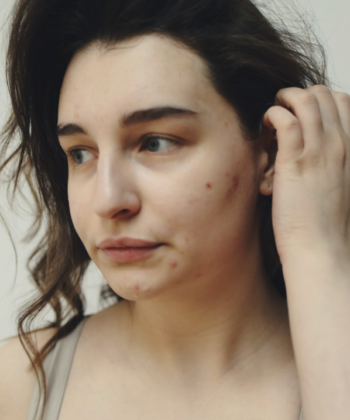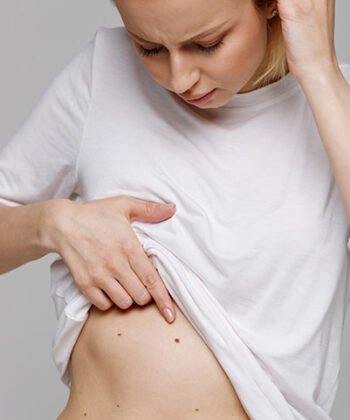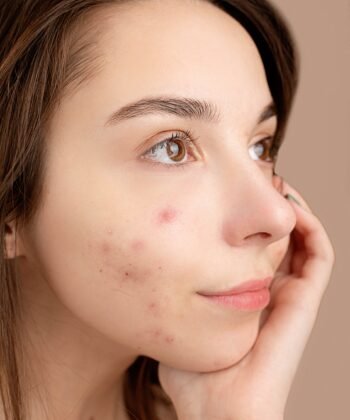Melanoma and Ultraviolet Light: What’s the Link?
According to Cancer Research UK, around 85% of melanomas in the UK are caused by too much ultraviolet radiation. The number of people being diagnosed with this type of cancer has increased and is now the 5th most common cancer in the UK.

What is melanoma?
Melanoma is a type of skin cancer that begins in skin cells called melanocytes. These cells create melanin, giving skin its colour and pigment. Also known as malignant melanoma or cutaneous melanoma, it is responsible for a small proportion of skin cancers in the UK. Despite this, it is liable for the majority of skin cancer deaths and is therefore the most dangerous form of skin cancer. It often presents itself as a newly formed pigmented lesion or alters the appearance of an existing mole on the skin. If left untreated, it can spread to other parts of the body.
What is UV radiation?
Ultraviolet (UV) radiation is electromagnetic energy that comes from the sun. It is the cause of suntans and sunburn which can penetrate the skin and damage DNA in your skin cells. Different types of UV radiation can cause this harm: UVA and UVB. UVB hits the superficial skin layers and is therefore responsible for delayed tanning and burning, premature skin ageing and the development of skin cancer. UVA however is far more harmful and reaches the deeper layers of skin. This then contributes to skin ageing and wrinkling, causes lasting damage and increases the risk of skin cancer.
The Evidence
There is extensive research that suggests UV radiation has a huge impact on our skin and that this may increase when exposure is intermittent. However, there are additional factors that determine how damaging it can be.
Sunbeds
Since 2009, the World Health Organization has classified sunbeds as carcinogenic to humans, meaning they have the potential to cause cancer due to the high intensity of UV light emitted. Research below shows how reducing use of sunbeds increases sun protection behaviours in young individuals and that exposure to either sun or sunbeds impacts young women more so than men due to addictive properties.
A recent US study showed that prohibitions against indoor tanning bed (ITB)use in youth reduced internet search volumes for tanning-related information. Among white teenage girls, ITB prohibitions reduced self-reported indoor tanning and increased sun protective behaviours. The paper also showed that youth ITB prohibitions significantly reduced the size of the indoor tanning market by increasing tanning salon closures and reducing tanning salon sales.(J Health Econ. 2023)
Adolescent and young adult women have a higher melanoma incidence than men. This may be, in part, due to the greater use of sunbeds, as well as intentional sun exposure among girls (Acta Derm Venereol. 2020).
Exposure to the sun in childhood and adolescence induces melanocytic naevi, which are known as markers of an elevated melanoma risk as well as possible precursors of melanoma. Strategies to reduce melanoma incidence should therefore begin by restricting exposure to sunlight in young children and adolescents (Hautarzt. 1992)
There is evidence in some studies indicating that indoor tanning might possess addictive characteristics. (S. Schneider. 2017)
UV exposure from sunbeds increases the risk of malignant melanoma significantly. If these are being used regularly as an attempt to gain a suntan, the intermittent radiation on the skin becomes very damaging. Primary prevention of malignant melanoma is mainly a question of minimizing the impact of ultraviolet radiation (including tanning booths) on the skin: limit time in the sun, cover up with clothing, and use a sunscreen with a protection factor of at least 15. (Ugeskr Laeger. 2000).
A study by the International Agency for Research on Cancer (IARC)11 found that individuals who have ever used a sunbed have a 15% higher relative risk of developing melanoma, compared with those who have never used a sunbed. Furthermore findings revealed that individuals who used their first sunbed before the age of 35 years have a 75% higher relative risk of developing melanoma compared to those who did not use a sunbed before that age.
According to a meta-analysis (combined analysis of multiple studies) of 27 studies by Gandini et al in 2012, each use of a sunbed is associated with a 1.8% increased risk of developing melanoma.
According to another study in Australia, more than 10 sessions in a sunbed doubles your risk of melanoma. Int J Cancer 2011 Cust et al Australian study.
Sunbed use significantly increases your risk of skin cancers and are best avoided.
Vitamin D
Though the vitamin D from the sun is good for bone health, too much sun exposure can result in the development of melanoma and skin cancers. The issue is complex and complete sun avoidance is not recommended. Complete avoidance of sunlight may result in low vitamin D, the consequences of which may take years to become apparent. Vitamin D deficiency is now a common health issue in Caucasian populations, with a significant impact on health in general (Curr Oncol Rep. 2013).
Studies in the past decade indicate that insufficient sun exposure may be responsible for 340,000 deaths in the United States and 480,000 deaths in Europe per year. Vitamin D has long been considered the principal mediator of the beneficial effects of sun exposure.
Other potential beneficial effects of sun exposure include the release of nitric oxide from the skin and the direct effects of ultraviolet radiation (UVR) on peripheral blood cells. These may help cause a decrease in blood pressure which is good for you.
Collectively, this evidence indicates it would be wise for people living outside the tropics to ensure they expose their skin sufficiently to the sun (Int J Environ Res Public Health. 2020). Ten or fifteen minutes a day of sun exposure in the UK summertime on the face and forearms may be sufficient to make a difference (depending on sun intensity and skin type).
Vitamin D may play a protective role in many diseases. Public health messages are advocating sun avoidance to reduce skin cancer risk but the potential deleterious effects of these recommendations for vitamin D metabolism have been poorly investigated. Public health campaigns advocating sun avoidance in fair skinned individuals may need to be revised in view of their risk of vitamin D deficiency (PLoS One. 2009).
The Risk Factors
Though the most significant risk factor for developing melanoma is exposure to UV radiation from the sun, there are several others to consider:
- Age- the risk of melanoma increases the older you get. More than 25% of people in the UK are aged 75 or over. It has also become more common in young people.
- Having a lot of moles, atypical moles or birthmarks
- Skin colour and freckles- the fairer your skin or the more freckles you have, the more at risk you are. Those with darker skin tend to be more protected.
- Having a family history of melanoma.
- Having a weakened immune system either from disease or medical causes such as immunosuppressive medication.
- Sunbeds- ultraviolet light in sunbeds can cause different types of skin cancer. If you use a sunbed before the age of 35 your risk increases.
Prevention of Melanoma
To reduce your risk of developing melanoma and to protect yourself from the sun’s harmful rays, follow the below tips:
- Wear protective clothing to cover your skin whilst out in the sun including long-sleeved tops and bottoms. Keep your face protected under a hat.
- Stay in the shade as much as possible and especially during peak sun hours (usually 10 am-4 pm)
- Apply a sunscreen with at least a UVB SPF 50 with 5 star UVA rating and reapply every few hours and after swimming or sweating
- Avoid sunbeds
- Regularly check your skin for any changing or unusual moles. If you notice a mole changing shape, size or colour, contact your GP or dermatologist as soon as possible.
Early Detection of Melanoma
It’s really important to pay attention to your skin and moles. Take note of what is normal for you and seek advice right away should you have any of the below symptoms.
Follow the ABCDE list to look out for warning signs of melanoma:
A: Asymmetrical - normal moles tend to be symmetrical, ones with an uneven, asymmetrical shape are not.
B: Border - pay attention to the edges of moles. Borders should not be blurred, jagged or irregular.
C: Colour - melanomas tend to be an uneven colour with possible shades of black, brown and pink.
D: Diameter - most melanomas are more than 6mm wide.
E: Evolving - melanomas may change colour, shape or size. The mole may become itchy, crusty or begin to bleed.
To Conclude
Although the evidence points to sun exposure playing a significant role in the development of melanoma, it cannot solely take full responsibility. There are many additional risk factors to take into consideration including: genetics, large number of moles, family history, UV exposure, age and skin pigment, to name a few. Some sun is required for healthy living. With this in mind, be cautious of your time in the sun and follow the preventative tips above.
Should you at any point feel that there is a change in a skin lesion or mole then seek the opinion of your Dermatologist.
REFERENCES
2 Carpenter CS, Churchill BF, Marcus M. Bad lighting: Effects of youth indoor tanning prohibitions. J Health Econ. 2023 Mar;88:102738. doi: 10.1016/j.jhealeco.2023.102738. Epub 2023 Feb 11. PMID: 36808016.
3 Raimondi S, Suppa M, Gandini S. Melanoma Epidemiology and Sun Exposure. Acta Derm Venereol. 2020 Jun 3;100(11):adv00136. doi: 10.2340/00015555-3491. PMID: 32346751; PMCID: PMC9189754.
4 Garbe C. Sonne und malignes Melanom [The sun and malignant melanoma]. Hautarzt. 1992 May;43(5):251-7. German. PMID: 1612913.
5 First evaluation of the Behavioral Addiction Indoor Tanning Screener (BAITS) in a nationwide representative sample. K. Diehl, T. Görig, E.W. Breitbart, R. Greinert, J.J. Hillhouse, J.L. Stapleton, S. Schneider. 2017
6 Weismann K, Lorentzen HF. Solvaner og melanomrisiko [Sunbathing habits and risk of melanoma]. Ugeskr Laeger. 2000 Jun 5;162(23):3307-10. Danish. PMID: 10895595.
7 Bataille V. Sun exposure, sunbeds and sunscreens and melanoma. What are the controversies? Curr Oncol Rep. 2013 Dec;15(6):526-32. doi: 10.1007/s11912-013-0342-4. PMID: 24142142.
8 Alfredsson L, Armstrong BK, Butterfield DA, Chowdhury R, de Gruijl FR, Feelisch M, Garland CF, Hart PH, Hoel DG, Jacobsen R, Lindqvist PG, Llewellyn DJ, Tiemeier H, Weller RB, Young AR. Insufficient Sun Exposure Has Become a Real Public Health Problem. Int J Environ Res Public Health. 2020 Jul 13;17(14):5014. doi: 10.3390/ijerph17145014. PMID: 32668607; PMCID: PMC7400257.
9 Glass D, Lens M, Swaminathan R, Spector TD, Bataille V. Pigmentation and vitamin D metabolism in Caucasians: low vitamin D serum levels in fair skin types in the UK. PLoS One. 2009 Aug 3;4(8):e6477. doi: 10.1371/journal.pone.0006477. PMID: 19649299; PMCID: PMC2714459.
10 El Ghissassi F, Baan R, Straif K, Grosse Y, Secretan B, Bouvard V, Benbrahim-Tallaa L, Guha N, Freeman C, Galichet L, Cogliano V; WHO International Agency for Research on Cancer Monograph Working Group. A review of human carcinogens--part D: radiation. Lancet Oncol. 2009 Aug;10(8):751-2. doi: 10.1016/s1470-2045(09)70213-x. PMID: 19655431.
11 Cust AE, Armstrong BK, Goumas C, Jenkins MA, Schmid H, Hopper JL, Kefford RF, Giles GG, Aitken JF, Mann GJ. Sunbed use during adolescence and early adulthood is associated with increased risk of early-onset melanoma. Int J Cancer. 2011 May 15;128(10):2425-35. doi: 10.1002/ijc.25576. PMID: 20669232; PMCID: PMC2993823.

Medically reviewed by Dr. Daniel Glass
UK trained Consultant Dermatologist Dr Daniel Glass is a General Medical Council registered skin specialist, qualified in both adult and paediatric Dermatology.











